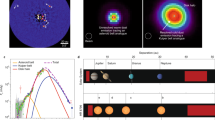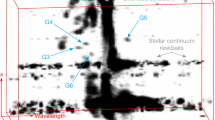Abstract
From the masses of the planets orbiting the Sun, and the abundance of elements relative to hydrogen, it is estimated that when the Solar System formed, the circumstellar disk must have had a minimum mass of around 0.01 solar masses within about 100 astronomical units of the star1,2,3,4. (One astronomical unit is the Earth–Sun distance.) The main constituent of the disk, gaseous molecular hydrogen, does not efficiently emit radiation from the disk mass reservoir5, and so the most common measure of the disk mass is dust thermal emission and lines of gaseous carbon monoxide6. Carbon monoxide emission generally indicates properties of the disk surface, and the conversion from dust emission to gas mass requires knowledge of the grain properties and the gas-to-dust mass ratio, which probably differ from their interstellar values7,8. As a result, mass estimates vary by orders of magnitude, as exemplified by the relatively old (3–10 million years) star TW Hydrae9,10, for which the range is 0.0005–0.06 solar masses11,12,13,14. Here we report the detection of the fundamental rotational transition of hydrogen deuteride from the direction of TW Hydrae. Hydrogen deuteride is a good tracer of disk gas because it follows the distribution of molecular hydrogen and its emission is sensitive to the total mass. The detection of hydrogen deuteride, combined with existing observations and detailed models, implies a disk mass of more than 0.05 solar masses, which is enough to form a planetary system like our own.
This is a preview of subscription content, access via your institution
Access options
Subscribe to this journal
Receive 51 print issues and online access
$199.00 per year
only $3.90 per issue
Buy this article
- Purchase on Springer Link
- Instant access to full article PDF
Prices may be subject to local taxes which are calculated during checkout


Similar content being viewed by others
References
Kuiper, G. P. The formation of the planets, part III. J. R. Astron. Soc. Can. 50, 158–176 (1956)
Kusaka, T., Nakano, T. & Hayashi, C. Growth of solid particles in the primordial solar nebula. Prog. Theor. Phys. 44, 1580–1595 (1970)
Weidenschilling, S. J. Aerodynamics of solid bodies in the solar nebula. Mon. Not. R. Astron. Soc. 180, 57–70 (1977)
Hayashi, C. Structure of the solar nebula, growth and decay of magnetic fields and effects of magnetic and turbulent viscosities on the nebula. Prog. Theor. Phys. 70 (suppl.). 35–53 (1981)
Carmona, A. et al. A search for mid-infrared molecular hydrogen emission from protoplanetary disks. Astron. Astrophys. 477, 839–852 (2008)
Beckwith, S. V. W., Sargent, A. I., Chini, R. S. & Guesten, R. A survey for circumstellar disks around young stellar objects. Astron. J. 99, 924–945 (1990)
Hartmann, L. Masses and mass distributions of protoplanetary disks. Phys. Scripta 014012 (2008)
Williams, J. P. & Cieza, L. A. Protoplanetary disks and their evolution. Annu. Rev. Astron. Astrophys. 49, 67–117 (2011)
Barrado, Y. &. Navascués, D. On the age of the TW Hydrae association and 2M1207334–393254. Astron. Astrophys. 459, 511–518 (2006)
Vacca, W. D. & Sandell, G. Near-infrared Spectroscopy of TW Hya: a revised spectral type and comparison with magnetospheric accretion models. Astrophys. J. 732, 8 (2011)
Weintraub, D. A., Zuckerman, B. & Masson, C. R. Measurements of Keplerian rotation of the gas in the circumbinary disk around T Tauri. Astrophys. J. 344, 915–924 (1989)
Calvet, N. et al. Evidence for a developing gap in a 10 Myr old protoplanetary disk. Astrophys. J. 568, 1008–1016 (2002)
Thi, W.-F. et al. Herschel-PACS observation of the 10 Myr old T Tauri disk TW Hya. Constraining the disk gas mass. Astron. Astrophys. 518, L125 (2010)
Gorti, U., Hollenbach, D., Najita, J. & Pascucci, I. Emission lines from the gas disk around TW Hydra and the origin of the inner hole. Astrophys. J. 735, 90 (2011)
Natta, A. et al. in Protostars and Planets V 767–781 (Univ. Arizona Press, 2007)
Draine, B. T. et al. Dust masses, PAH abundances, and starlight intensities in the SINGS galaxy sample. Astrophys. J. 663, 866–894 (2007)
Pilbratt, G. et al. The Herschel Space Observatory. Astron. Astrophys. 518, 3–8 (2010)
Poglitsch, A. et al. The Photodetector Array Camera and Spectrometer (PACS) on the Herschel Space Observatory. Astron. Astrophys. 518, L2 (2010)
Hoff, W., Henning, T. & Pfau, W. The nature of isolated T Tauri stars. Astron. Astrophys. 336, 242–250 (1998)
Linsky, J. L. Deuterium abundance in the local ISM and possible spatial variations. Space Sci. Rev. 84, 285–296 (1998)
Lissauer, J. J. & Stevenson, D. J. in Protostars and Planets V 591–606 (Univ. Arizona Press, 2007)
Greaves, J. S. & Rice, W. K. M. Have protoplanetary discs formed planets? Mon. Not. R. Astron. Soc. 407, 1981–1988 (2010)
Mordasini, C., Alibert, Y., Benz, W., Klahr, H. & Henning, T. Extrasolar planet population synthesis. IV. Correlations with disk metallicity, mass, and lifetime. Astron. Astrophys. 541, A97 (2012)
Tachihara, K., Neuhäuser, R. & Fukui, Y. Search for remnant clouds associated with the TW Hya association. Publ. Astron. Soc. Jpn 61, 585–591 (2009)
Hogerheijde, M. R. et al. Detection of the water reservoir in a forming planetary system. Science 334, 338–340 (2011)
Dartois, E., Dutrey, A. & Guilloteau, S. Structure of the DM Tau outer disk: probing the vertical kinetic temperature gradient. Astron. Astrophys. 399, 773–787 (2003)
Wright, C. M., van Dishoeck, E. F., Cox, P., Sidher, S. D. & Kessler, M. F. Infrared Space Observatory–Long Wavelength Spectrometer detection of the 112 micron HD J = 1 → 0 line toward the Orion Bar. Astrophys. J. 515, L29–L33 (1999)
Bertoldi, F., Timmermann, R., Rosenthal, D., Drapatz, S. & Wright, C. M. Detection of HD in the Orion molecular outflow. Astron. Astrophys. 346, 267–277 (1999)
Neufeld, D. A. et al. Spitzer observations of hydrogen deuteride. Astrophys. J. 647, L33–L36 (2006)
Brinch, C. & Hogerheijde, M. R. LIME - a flexible, non-LTE line excitation and radiation transfer method for millimeter and far-infrared wavelengths. Astron. Astrophys. 523, A25 (2010)
Acknowledgements
Herschel is an ESA space observatory with science instruments provided by European-led Principal Investigator consortia and with important participation from NASA. Support for this work was provided by NASA through an award issued by JPL/Caltech and by the US National Science Foundation under grant 1008800. This paper makes use of the following Atacama Large Millimeter/submillimeter Array (ALMA) data: ADS/JAO.ALMA#2011.0.00001.SV. ALMA is a partnership of ESO (representing its member states), the NSF (USA) and NINS (Japan), together with the NRC (Canada) and the NSC and ASIAA (Taiwan), in cooperation with the Republic of Chile. The Joint ALMA Observatory is operated by ESO, AUI/NRAO and NAOJ.
Author information
Authors and Affiliations
Contributions
E.A.B., L.I.C., U.G. and K.Z. performed the detailed calculations used in the analysis. J.D.G. reduced the Herschel data. S.M.A. provided detailed disk physical models and U.G. provided thermochemical models, both developed specifically for TW Hya. E.A.B. wrote the manuscript with revisions by N.J.E. All authors were participants in the discussion of results, determination of the conclusions and revision of the manuscript.
Corresponding author
Ethics declarations
Competing interests
The authors declare no competing financial interests.
Supplementary information
Supplementary Information
This file contains Supplementary Text and Data, additional references, Supplementary Table 1 and Supplementary Figure 1. (PDF 196 kb)
PowerPoint slides
Rights and permissions
About this article
Cite this article
Bergin, E., Cleeves, L., Gorti, U. et al. An old disk still capable of forming a planetary system. Nature 493, 644–646 (2013). https://doi.org/10.1038/nature11805
Received:
Accepted:
Published:
Issue Date:
DOI: https://doi.org/10.1038/nature11805
This article is cited by
-
Protoplanetary Disk Science with the Orbiting Astronomical Satellite Investigating Stellar Systems (OASIS) Observatory
Space Science Reviews (2023)
-
Herbig Stars
Space Science Reviews (2023)
-
Depletion of gaseous CO in protoplanetary disks by surface-energy-regulated ice formation
Nature Astronomy (2022)
-
Closing gaps to our origins
Experimental Astronomy (2022)
-
Bringing high spatial resolution to the far-infrared
Experimental Astronomy (2021)
Comments
By submitting a comment you agree to abide by our Terms and Community Guidelines. If you find something abusive or that does not comply with our terms or guidelines please flag it as inappropriate.



